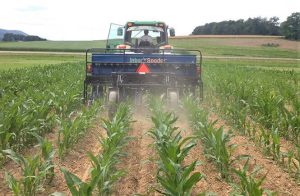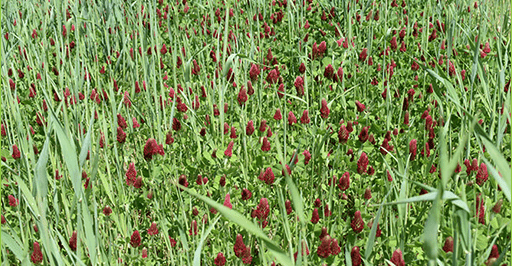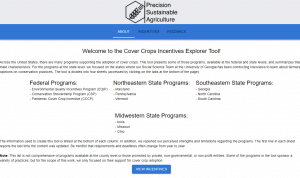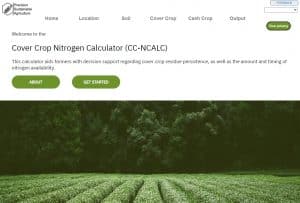Cover Crops as a Weed Management Tool
This page focuses on how to manage weeds with cover crops. It imparts basic cover crop concepts and provides users with updated content on how to create a plan to manage weeds with this powerful tool. Keep in mind that cover crops are best used in tandem with other tactics, such as herbicides, narrow row spacing, and tillage to control weeds.
What is a “cover crop”?
There are multiple definitions for “cover crop”. In general, a cover crop is any plant that is grown when the ground would otherwise be fallow (bare). (Note that cover crops can be interseeded with cash crops for certain purposes.) A cover crop is generally not harvested but rather is grown for the other benefits it can provide to a cropping system (sometimes referred to as ecological services). Some farmers do graze cover crops or harvest them for forage or seed.
Why grow a cover crop?
Cover crops provide many potential benefits to an agroecosystem. They cover the soil, decreasing erosion. They add carbon to the soil, increasing organic matter and improving soil health. They take up N and P that would otherwise run off or leach into bodies of water. They help suppress weeds. They also provide habitat and food for wildlife and beneficial insects.
Are there any risks or other unwanted effects associated with cover crops?
Cover crops may provide overwintering habitat for insects or serve as a host for some diseases. Some cover crops are difficult to terminate, such as rapeseed. Incomplete termination may cause issues with planting or competition with subsequent crops, and may allow cover crops to set seed resulting in future weed problems. Carefully choose each species planted as a cover crop.
Important Concepts for Managing this Tool
1. What impacts do cover crops have on weeds?
How do cover crops contribute to weed management?
Cover crops contribute to weed management at multiple points in their life cycle. Preparing the field for cover crop planting, such as with a burndown herbicide or tillage, kills weeds. When cover crops are actively growing, they compete with weeds for space, light, nutrients, and water, depriving weeds of needed resources. Cover crops alter the environmental conditions at the soil surface, which can prevent or delay germination of some weed species. Certain cover crop species release compounds that discourage weed seed germination or kill weed seedlings (i.e. through allelopathy). These compounds are released during active cover crop growth and only persist for approximately two weeks after termination. The same methods that terminate a cover crop, such as herbicide application or flailing + disking under, will also kill weeds. Finally, the cover crop mulch smothers weeds by creating a physical barrier and blocking light.
How do cover crops assist in herbicide resistance management?
Cover crop use, in combination with other weed control methods, adds diversity to a weed management program. The more diverse a weed management program is, the less reliant it is on one or a few herbicides, and the less likely herbicide resistance is to develop or spread.
Why is it said that cover crops “suppress” weeds rather than “control” weeds?
It is well known that herbicides control weeds; in other words, they have the ability to kill weeds. Cover crops, however, are living organisms with the ability to compete with other species for different resources (light, water, nutrients). By competing with weed species for resources, cover crops stunt weed growth (i.e. weeds grow less tall and put on less biomass), preventing weeds from decreasing cash crop growth and yield. However, these weeds are alive (unlike after a successful herbicide application) and could still set seed. This is why we say cover crops “suppress”, rather than “control”, weeds. Cover crops also alter the soil environment and impact (reduce) the germination and emergence of weeds. As a result, there are fewer weeds as well. Farmers can plant small test plots to easily see what a cover crop does to reduce weed impact in their crops by observing how big the weeds are in areas with cover crops as compared to areas without cover crops.
What indicates that a cover crop is contributing to weed suppression?
Relative to fallow or no cover crop, delays in weed emergence (i.e. delaying weed germination so the weed has less time to grow and produce seed), reduced weed density (i.e. fewer weeds), and reduced weed biomass (i.e. smaller weeds) all indicate that cover crops are contributing to weed suppression. Weeds that are delayed in emergence, reduced in number, and smaller will produce fewer seeds and therefore fewer issues in the future. Practically speaking, researchers most often use change in weed density or biomass production to quantify cover crop impact on weeds.
What weeds are good targets for suppression by cover crops?
Winter annual weeds, including horseweed/marestail, are good candidates. Also, small seeded summer annual weeds such as pigweeds are good targets. Perennial weeds such as Johnsongrass or pokeweed are not suppressed by typical fall-planted cover crops.
Can perennial weeds ever be suppressed with cover crops?
Cover crops, in conjunction with other weed control tactics such as mowing, can be used to address perennial weed infestations. This tactic is more common in organic systems, which don’t have herbicide options, because it often means taking a field out of cash crop production for a season to plant and manage the cover crop to suppress the problem weeds. For example, Canada thistle may be managed by planting a summer annual cover crop like Sudangrass, then mowing it (and the weeds in it) several times over the summer.
2. What should we do to establish a good cover crop for weed management?

It is crucial to have a good cover crop establishment when weed management is the main goal. A good, well-established cover crop stand promotes biomass production, which is the key to weed management. Drilling is the most commonly used and effective method to seed cover crops and get adequate amounts of biomass. However, there is limited time in some cropping rotations after cash crop harvest but before the start of cold weather to plant a cover crop and get it established. Corn and soybean growers often struggle to get a cover crop planted or find themselves limited to growing cereal rye, which tolerates the latest planting of any cover crop due to its hardiness and fast growth.
However, interseeding (either with a specialized drill or an air seeder) can expand the cover crop planting window by allowing a grower to plant before cash crop harvest. Successfully interseeded cover crops provide similar levels of weed suppression as drilled cover crops. Interseeding equipment and methods have been most refined for corn rotations, using either an interseeder planter which drills the seed or an air spreader which propels the seed through planting tubes using air flow. Both planting methods place the cover crop seed between the rows of corn. Interseeder drills are used when corn is at the V4-V6 growth stage, while air spreaders can be used from V6 up until a few days before harvest. In both cases, the cover crop sprouts and then stops growing until after cash crop harvest, when the amount of light reaching the cover crop increases and promotes cover crop growth. Some cover crops are more shade tolerant than others and thus are a better choice for interseeding.
3. For weed management, are all cover crops created equal?
How do we select the best cover crop for weed suppression?
The best cover crop species for weed suppression establish easily, grow quickly, rapidly shade the ground, produce large amounts of biomass, and have lasting residue that acts as a mulch after the cover crop has been terminated. In general, grass cover crop species suppress weeds better than legumes. Cereal rye, winter wheat, and oats are some of the best grass cover crops for weed suppression. Farmers that want to both fix nitrogen and suppress weeds with their cover crop should plant a mixture of grass and legume, such as cereal rye+hairy vetch. Forage (or oilseed) radish can provide good weed suppression through early spring when planted in the fall. Hairy vetch is one of the best legumes for weed suppression in the spring, but in colder regions such as the mid-Atlantic or Northeast US, it benefits from planting in mixture with oats or cereal rye to help it establish and better suppress weeds in the fall. For fields with particularly intractable weeds, creative management of a cover crop can improve weed control efforts. For example, planting Sudangrass in early summer into Canada thistle-infested patches and then periodically mowing the cover crop can drastically decrease the thistle population.

Does weed suppression by cover crops vary by region?
Yes. Latitude (i.e. how far north or south a location is) affects the development of different cover crop species differently. Altitude can also contribute to growth differences, even at the same latitude, because temperature patterns are different at different altitudes. Differences in soil quality and structure across regions also contributes to differences in cover crop development. When seeded in the southern US, cereal rye can be influenced by the higher average annual temperatures, affecting biomass production and, as a consequence, weed suppression. In contrast, northern latitudes usually favor large biomass accumulation which contributes to weed suppression.

Are cover crop mixtures better than monocultures? Cover crop mixtures can provide more benefits than monocultures, but they can also be more difficult to manage. A cereal rye+hairy vetch mixture can provide both excellent weed suppression (both species provide weed suppression) and add N to the system (because vetch fixes N). However, when terminating a cereal rye+hairy vetch mixture you have to account for both species when deciding when and how to terminate it. If you want to roller-crimp the rye+vetch mixture, you need to do so at the ideal time for whichever species is slower to reach its ideal termination time to ensure that both species in the mix are successfully terminated.
4. Does cover crop biomass matter for weed suppression?
How much cover crop biomass is needed to suppress weeds?
Weed suppression from cover crops increases as biomass increases, up to a certain level of biomass. Research conducted across the mid-Atlantic US shows that significant weed suppression can only be achieved consistently when mulch biomass exceeds 7000 lb/acre; however, this finding is not consistent across other climates and soils. Preliminary data from a USDA-ARS Area-Wide weed project shows that significantly less biomass (up to 2500 lb/acre) is required for weed suppression in the North-Central region. Weed suppression is being evaluated in studies like the one shown in this video across the US to answer this question.
Early cover crop termination (left) vs late termination (right). Biomass increased four fold when termination was conducted close to soybean planting date.
How does cover crop management affect weed suppression?
Cover crop biomass is the key factor driving weed suppression. Early planting produces more biomass and delivers better weed suppression than late planted cover crops. In a 2011 study in Pennsylvania, a cereal rye cover crop planted on Aug. 25 produced almost 2500 lbs/A more biomass on average than rye planted on Oct. 15. Termination timing is perhaps even more crucial for weed suppression. For example, recent studies show that cereal rye terminated at the tillering stage results in low rye biomass and consequently less weed suppression. In the 2011 Pennsylvania study mentioned above, rye more than doubled its biomass between the beginning and end of May. Delaying cover crop termination until close to cash crop planting gives the cover crop the maximum amount of time possible to accumulate biomass, key to suppressing weeds through competition and then as a mulch. Early seeding dates combined with later termination dates maximize biomass production, though a later termination date can partially compensate for a later planting date. Drilling cover crops rather than broadcast seeding results in better stands and more biomass, as well.
If, for any reason, seeding is delayed, would an increase in seed density compensate for the potential loss of biomass due to late planting?
The answer to this question depends on both the latitude of the farm in question (meaning how far north you are) and the cover crop species in question. For example, Mirsky et al. (2017) estimated that increasing the seeding rate increases hairy vetch biomass up until a cutoff of September 15 (for early-terminated vetch) in New York, after which increased seeding rates do not make up for later planting dates. In Maryland, the same was estimated to be true up until October 25. Note that cover crop biomass is determined by planting and termination dates as well as seeding rate. Early termination of a cover crop in the spring reduces the risk of the cover crop interfering with the planting of the following cash crop but also decreases the amount of biomass a cover crop can produce and thus decreases spring/summer weed suppression potential.
5. How do I terminate my cover crop for weed suppression?

How should I terminate my cover crop?
The choice of cover crop termination method depends on cover crop and crop rotation species, available equipment, and goals. Cover crop termination methods fall into three general categories: winter-kill, chemical, or mechanical methods. See this page on TERMINATION METHODS for more information, or view the PDF.
What is “planting green”? Is it better for weed management?
“Planting green” is a term used to describe the practice of planting a cash crop into a live cover crop. The cover crop is then terminated after planting, usually not more than two weeks after cash crop planting. Termination methods will be more limited when planting green, as the method chosen can’t be one that interferes with the recently planted cash crop.
In terms of weed management following the cover crop, planting green can allow cover crops to gain more biomass by growing for an additional few weeks, increasing weed suppression. That extra biomass often provides additional benefits such as the opportunity to plant sooner in a wet spring and a thicker mulch layer that can better conserve soil moisture later in the season. Also, delaying termination date will delay decomposition of the cover crop mulch, prolonging weed suppression.
In this video, Trey Hill from Harborview Farms explains how he manages 8000 acres with no-till and planting green and how it contributes to outstanding weed management.
6. How do I prevent cover crops from becoming future weeds?
What do you mean, “Cover crops can become weeds”?
Although cover crops can provide many benefits to a cropping system as mentioned above, they can also act like weeds. Remember that a weed is any plant growing where it is not wanted.
Cover crops can become weeds when hard seed lingers in the soil after planting and sprouts while a cash crop is growing. Hairy vetch is well-known for its hard-seedness. Cover crops can become weeds if they are allowed to go to seed. Buckwheat, oats, rye, and radishes are known to volunteer in the following cash crop. Cover crops can also become weeds if they are not successfully terminated (killed) prior to cash crop planting. Annual ryegrass, hairy vetch, and some clovers can be difficult to successfully terminate in the spring.
Keep in mind that herbicide resistance has been documented in some cover crops, notably annual ryegrass. When relying on herbicides to terminate a cover crop, be prepared to use a second termination method (or herbicide) if the first fails. Likewise, mechanical termination using a roller-crimper must be done at the correct cover crop life cycle stage, or the cover crop may not be fully killed.
What cover crop species are least likely to become weeds?
Cover crop species least likely to become weeds are those that do not have a hard seed or that winter-kill (or are easily terminated in the spring) before they can set seed. Examples include fall-planted oats and phacelia.
What species are most likely to become weeds?
The cover crop species most likely to become weeds are those that have hard seed (such as rapeseed), that grow and set seed quickly (such as buckwheat), and those that are difficult to control (such as rapeseed). Hard seeded cover crops may not germinate within the cover crop growing season. Rather they may germinate in subsequent cash crops and become weeds there. Cover crops that are difficult to control may survive termination potentially leading to interference with planting the cash crop, competition with the cash crop, and produce seed resulting in future weed problems. Note that difficulty in control is often dependent on the control options in the rotational crop. For instance, volunteer cereal rye is relatively easy to control in corn or soybeans, but very difficult to control in winter wheat.
Use the appropriate method and timing to terminate cover crops in the spring. For example, while glyphosate alone can terminate most grass cover crops (such as cereal rye), many legume cover crops require a tank mixture such as glyphosate + 2,4-D or dicamba.
Be prepared to make a second pass or use a second method if the initial attempt at terminating a cover crop is not fully successful, or be prepared to control the cover crop (now weed) in the cash crop.
Choose cover crops that fit your cropping system. Farmers who grow small grains may choose a legume like crimson clover rather than hairy vetch because hairy vetch is difficult to control in small grains, while crimson clover is easier to control and poses less risk of contaminating the harvested small grains. If potential delayed cash crop planting is a concern, don’t plan to roller-crimp a cover crop to terminate it (because the cover crop may not reach the correct stage for termination in time for timely cash crop planting).
Cover crops that are a concern in rotational crops should be managed to avoid seed set. For example, buckwheat should be terminated soon after bloom, which can occur within six weeks of planting the buckwheat. Avoid planting radish so early in the fall (in warm climates) that it has time to set seed before it will winter kill.
What are the best methods to prevent cover crops from becoming weeds?
7. Do cover crops make economic sense as a weed management tool?
There are concrete costs associated with cover crops such as seed, planting and termination. But growers who adopt cover crops long-term or are facing challenges such as soil compaction or herbicide-resistant weeds, can see the value of the cover crops overcome those concrete costs. Weed suppression benefits of using cover crops can include a reduced number of herbicide passes and decreased weed seed contamination of the harvested grain.
This article (Cover Crops Earn their Keep Combating Herbicide-Resistant Weeds), based on a SARE Technical Bulletin, will explain how much a cover crop can pay and how to get the most of your cover crop.
Print this document by clicking the button below:
For more information on cover crops for weed suppression, click the buttons below:
Knowing how much cover crop biomass is growing in your field is a critical step to knowing what level of weed suppression or nutrients you can expect from it. See a step-by-step video on how to collect, dry and measure a cover crop biomass sample here:
Both the federal government and many states offer programs with financial assistance for farmers trying to integrate cover crops into their farming operation. For help sorting through federal and select state cover crop incentive programs, use this tool:
For help selecting the right cover crop, explore the tools below:
Authors
- Victoria Ackroyd
- Michael Flessner
- Kara Pittman
- Claudio Rubione
- Lovreet Shergill
- Mark VanGessel
- Steven Mirsky
Citations:
- Bicksler AJ, Masiunas JB (2009) Canada thistle (Cirsium arvense) suppression with buckwheat or sudangrass cover crops and mowing. Weed Technol 23:556–563
- Mirsky SB, Ackroyd VJ, Cordeau S, Curran WS, Hashemi M, Reberg-Horton SC, Ryan MR, Spargo JT (2017) Hairy vetch biomass across the eastern United States: effects of latitude, seeding rate and date, and termination timing. Agron J 109:1510–1519
- Mirsky SB, Curran WS, Mortenseny DM, Ryany MR, Shumway DL (2011) Timing of cover-crop management effects on weed suppression in no-till planted soybean using a roller-crimper. Weed Sci 59:380–389
- Myers R, Weber A, Tellatin S (2019) Cover crop economics: Opportunities to improve your bottom line in row crops. SARE Tech Bull
- PennState Extension (2010) Suppressing weeds usıng cover crops in Pennsylvania. Pennsylvania State University
- Ruis SJ, Blanco-Canqui H, Creech CF, Koehler-Cole K, Elmore RW, Francis CA (2019) Cover crop biomass production in temperate agroecozones. Agron J 111:1535–1551
- Snapp SS, Swinton SM, Labarta R, Mutch D, Black JR, Leep R, Nyiraneza J, O’Neil K (2005) Evaluating cover crops for benefits, costs and performance within cropping system niches. Agron J 97:322–332































































































